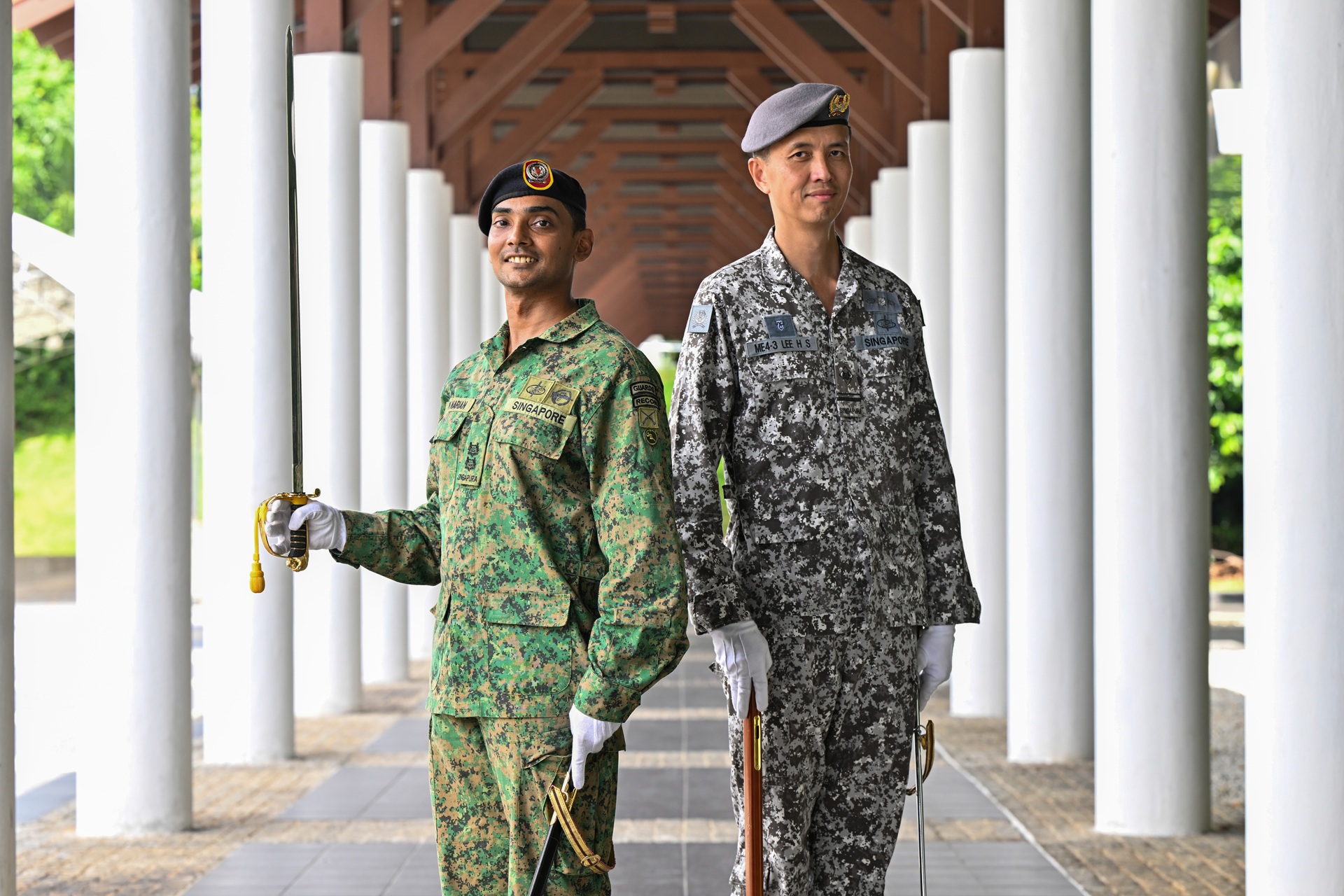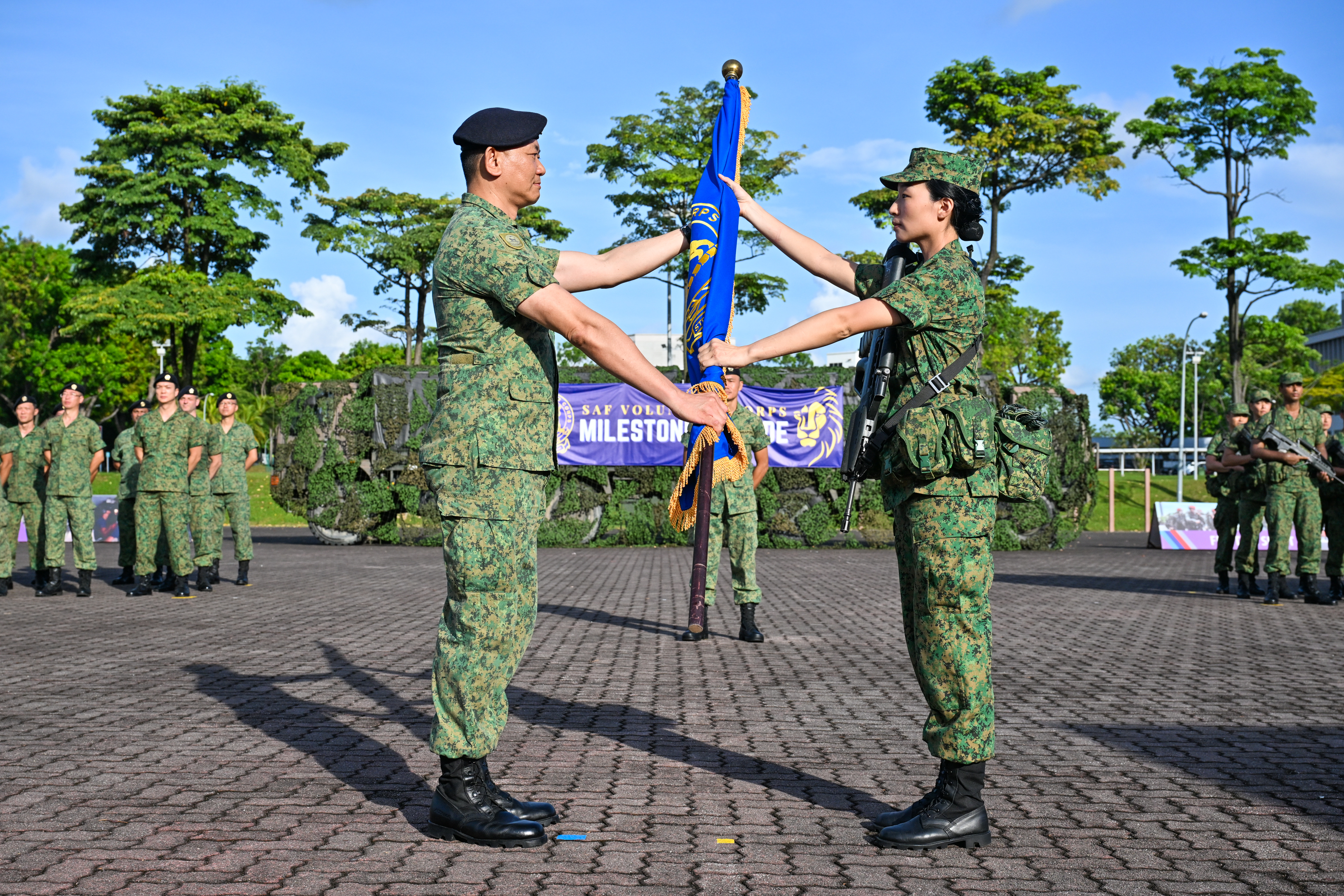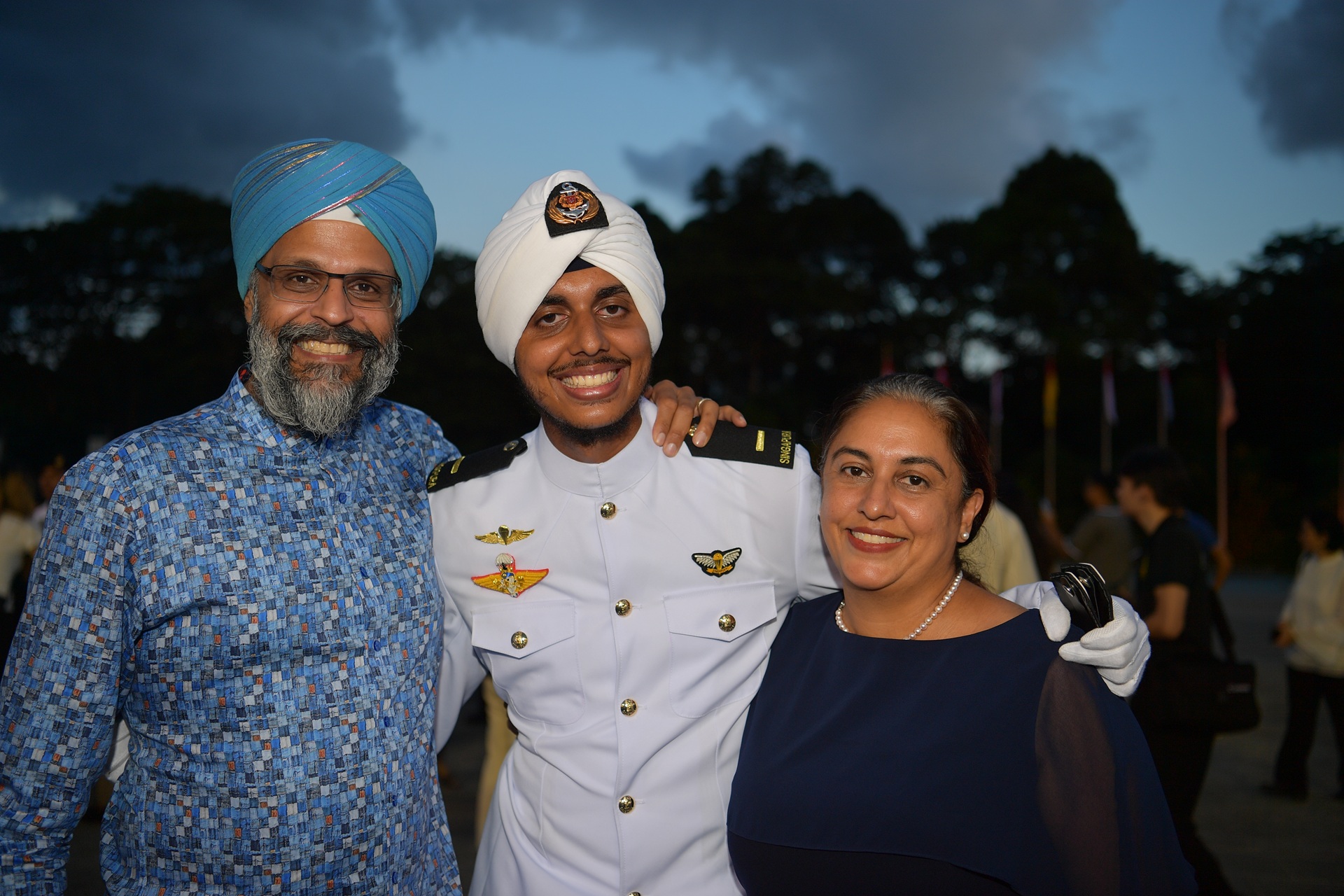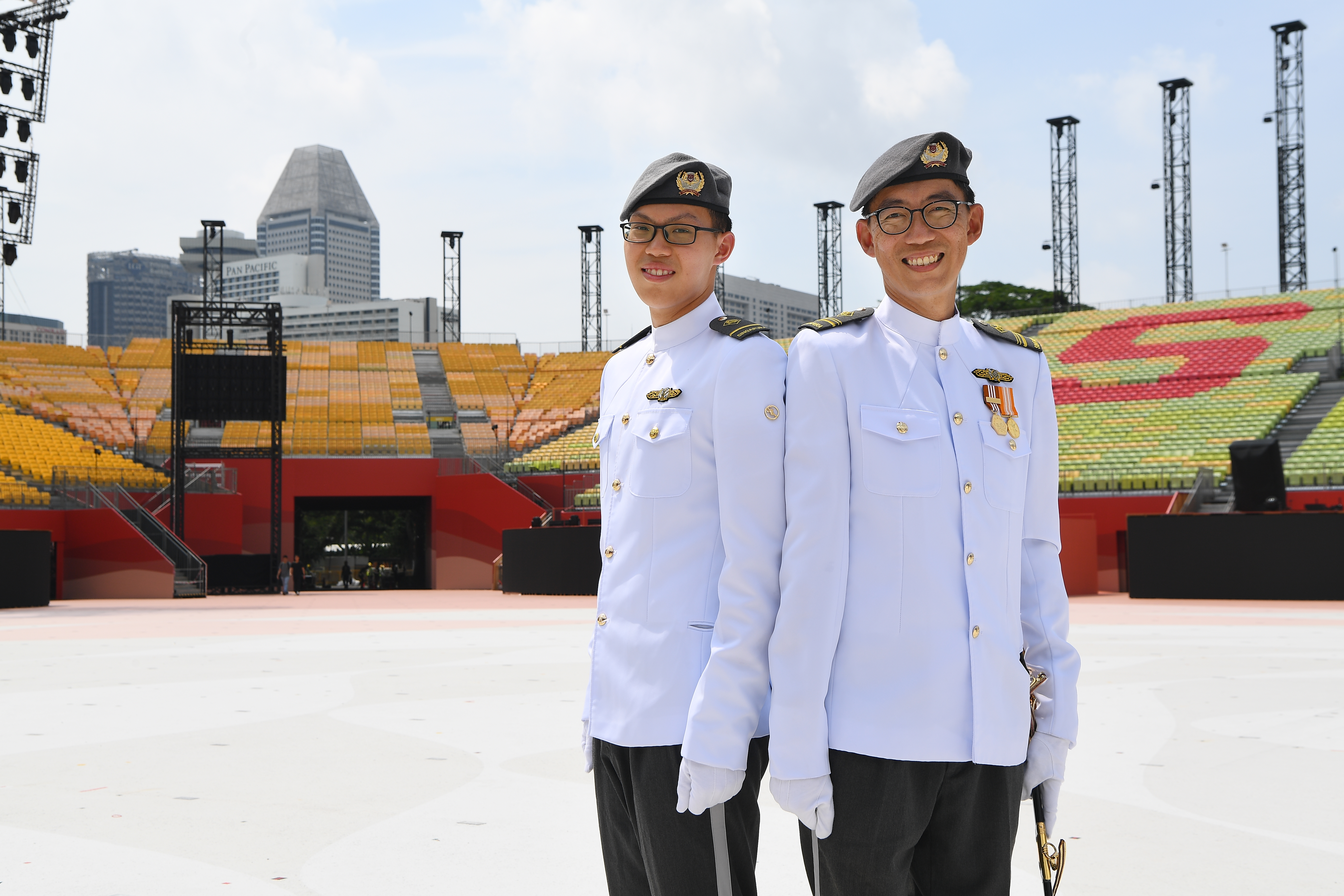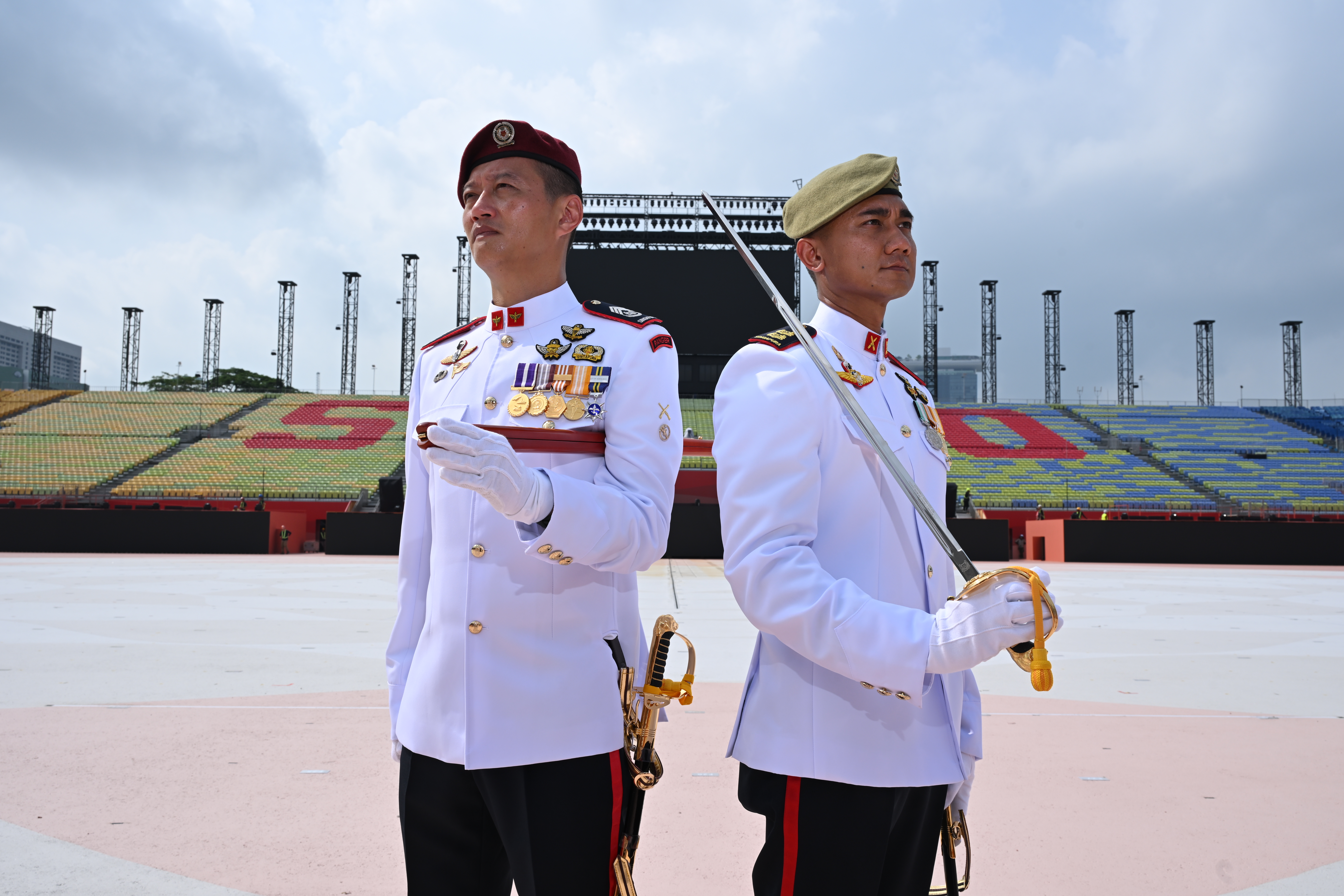A STROKE OF GENIUS
How does the Republic of Singapore Navy (RSN) build up its culture of innovation? PIONEER looks at some of the ideas that have taken root and are bearing fruit.// STORY BENITA TEO
// PHOTOS CHAI SIAN LIANG & CHUA SOON LYE / ILLUSTRATIONS BRYAN LOO
Sometimes it’s the itch you can’t scratch that ruins your day. But once you reach it, you can focus better on the important things.
In the same way, the RSN is able to stay focused on its duty of keeping Singapore’s sea lines safe and secure because its people are always actively looking for solutions to the stumbling stones that hinder their daily work. This was achieved by fostering a strong culture of innovation in the Navy.
“We see innovation as our lever to achieve the larger outcomes we want to achieve, amid the constraints of manpower and fiscal resources,” said Head Naval Logistics Military Expert (ME) 7 Andy Tay.
He is the Chairman of the RSN Innovation and Smart Enterprises (RISE) committee, which comprises deputy formation commanders and policymakers. By bringing stakeholders together, it aims to break down the walls that hinder the development of innovative ideas.
For ME6 Joses Yau, Head of the Smart Futures Innovation Office (SFIO), innovation is a means of generating capacity and capability. “We generate capacity through practical innovation. We want to solve real pain points on the ground and make sure our people have the capacity to look at doing other things better — which is to be able to fight better,” he explained.
The SFIO was stood up in January as a bridge between the RISE committee and innovation project teams. Through measures such as teaching innovation techniques and organising events like the inaugural pitchfest, SFIO wants every RSN sailor to know that they are capable of innovation and solving problems. “We are targeting the ecosystem to ensure that innovation can thrive. I believe everyone can innovate; the steps are there. It’s up to them to own it,” said ME6 Yau.
THE SITUATION
Thorough security screening is a must when it comes to accessing a base or camp, but the lengthy administrative process can be a real pain for servicemen.
When visiting a base, be prepared to wait for up to 10 days to be cleared by base security. And remember to turn up early at the pass office to exchange your identity card for a visitor’s pass.
Large groups of external contractors can expect to queue for up to two hours. Then there are the manual vehicle checks by security troopers at the entrance. And don’t forget to return your pass at the end of the day!
THE SOLUTION
What if you could do away with all that and just use the items you already have on hand — your mobile phone, and your face?
A new base access system could soon be introduced to Changi Naval Base (CNB) — and possibly all other camps and bases. It will comprise a 2FA or two-factor authentication system that uses a personnel’s biometric details and mobile phone.
Base residents or visitors first have to register their details through a mobile authentication app, which will also inform them of their security clearance. Sensors at the base will pick up the MAC (Media Access Control) address — which are unique hardware identification numbers — of their phones when they arrive to verify their registration.
At the entrance gantry, they go through the second layer of authentication. They will be scanned by the biometric scanners and allowed entry if they meet both the authentication criteria.
Only when an unauthorised personnel is detected will base security be notified and Changi Defence Squadron (CDS) sea soldiers be despatched to investigate.
Uncompromising security features
“Your face is your ‘pass’, so why do you need another pass? Your own biometric is your best pass,” said Force Protection, Capability and Doctrine Development Branch staff officer Captain (CPT) Sanipher Sin, a member of the team which came up with the idea of a card-less base.
For two months, Team Navy did their research, gathering feedback from stakeholders such as military personnel who were base residents or visitors, and monitoring traffic during peak and non-peak hours.
The first phase of trials was carried out this year from 26 Feb to 20 Apr. Three biometric verification systems were trialled: finger wave, iris recognition and facial recognition.
“We had an audacious goal: to clear one person per second,” CPT Sin revealed. During the trial, the systems came close, taking about 1.5 seconds to read each biometric detail.
Even though efficiency and speed were the primary intents, the team knew that security could not be compromised. “The challenge was not to bypass any existing security procedures,” said team member CPT Amoz Yeo, Officer Commanding of the Base Security Company in CDS.
Over the 40 days, they carried out about 2,000 trial runs on the biometric systems to test the accuracy of its data collection. Trials were also carried out on twins and similar-looking people, which the system easily differentiated. The team even made a rubber cast of a trial participant’s face, and tested it on the facial recognition scanner!
“He wore the mask through the scanner, but the system was able to detect that it wasn’t a real person!” said CPT Sin.
Redeploying soldiers
A vehicle x-ray will replace the manual checks currently carried out by sea soldiers. The x-ray will be able to detect weapons and explosives the moment the vehicle passes through the scanner.
With technology replacing the need for boots on the ground, the sea soldiers can better focus on their training and operations.
“One of our aims was to cut down manpower for this laborious work,” CPT Sin explained.
“The sea soldiers can be redeployed for other work or focus on their training while the system does the work of screening and authenticating.”
THE SITUATION
The frigate’s Ship Management System notifies the Machinery Control Room of a problem in one of the engine rooms. There is a problem with the diesel generator (DG), and a marine engineer is despatched to check.
It is a defect that requires a complex maintenance procedure to be carried out, and the engineer goes through the manual to confirm the required steps.
He finds the page, but even then, he is unfamiliar with some of the spare parts, which look similar but are made of different materials and have different functions. Which tool should he use and where should the spare parts be fitted? Meanwhile, time is running out as the ship requires the DG to be operational to continue with its mission.
THE SOLUTION
Augmented reality or AR glasses that guide engineers’ hands through the steps for difficult maintenance work, and a mobile phone app to help troubleshoot incidents quickly and accurately.
Info at your fingertips
If you’ve always wished for a memory chip to be implanted in your head to help you remember stuff, this is pretty close. The RSN worked with the Defence Science and Technology Agency (DSTA) to design AR glasses that can help guide marine engineers through complex tasks.
When carrying out repairs or maintenance on the DG, engineers simply put on the glasses, and sequential directions will then appear within their line of vision. Animations of the necessary tools and spares will also be mapped over the parts that require servicing to guide them through the procedures.
Complementing the glasses is a handset app that it is paired to. Engineers can key in the symptoms surfaced by the Ship Management System, such as “cylinder B1 high temperature”, and the app will help with troubleshooting.
After narrowing down the possible problems, it will consolidate and display the steps necessary to rectify it.
For steps that require AR guidance, the engineer can then activate the glasses and follow the instructions shown. It will also highlight the specific tools and spare parts necessary and allow the engineer to tick off the equipment he has picked up to avoid missing anything.
“We wanted to solve two problems faced by shipboard engineers when they are out at sea,” explained ME5 Adrian Choong, an RSN Innovator-inResidence (IIR). The IIRs work with DSTA and RSN to incorporate new technologies into the Service.
“The first is to eliminate the use of hardcopy maintenance manuals and provide crew with a handsfree experience. This is important because maintenance work can be difficult in bad sea states. The second is to speed up the process of diagnosing defects in platform systems when out at sea.”
“(Besides) making maintenance processes safer and more efficient, there’s also cost avoidance when engineers are able to boost first-time fixes,” added Ms Lena Lim, a Project Manager from DSTA’s Digital Hub.
A gold mine of information
Converting all the information from hardcopy manuals was no easy task. In addition, the team discovered that a lot of knowledge came from years of experience — details such as knowing which parts of the DG were hot and to avoid, and how to prioritise various troubleshooting tasks.
These were not documented, but passed from trainer to trainee through word-of-mouth. The team had to interview the senior engineers to tap into this wealth of knowledge. But the arduous task was worth the effort, said Ms Lim. “Being able to capture the tacit knowledge means we’ll be able to digitise, archive and make sure the next generation of engineers have access to it,” she explained. The exercise also allowed the knowledge to be verified and centralised for easy access.
Building confidence
The AR glasses and handset have proven to be a good training tool for new engineers, ME5 Choong observed. “They find it useful to have an overview of the task. It builds their confidence and eliminates questions of what needs to be done next. They are better able to work without supervision.”
Supervisors are still able to monitor their trainees’ progress through the glasses’ built-in cameras, which broadcast the trainees’ view to tablets. The sessions can also be recorded for future review.
However, fellow IIR ME5 Aw Chee Giap cautioned that the equipment is not meant to replace the in-depth study of engineering processes.
“You need a strong foundation in everything you do, and this is only the last-mile push,” he explained. “This helps to cut out the flipping of manuals and eliminate guesswork, but you cannot take short-cuts, as with all engineering work.”
THE SITUATION
Gaming is no longer just child’s play. Many schools have introduced gaming into lessons as a way of enhancing learning for students. It is believed to improve knowledge absorption and retention, and better engage learners. So how can the RSN leverage this to help new sailors master the necessary skillsets faster and learn better?
THE SOLUTION
Learn about naval warfare with the mobile gaming app, Warriors of the Sea. Using open-source information, it aims to reinforce the fundamentals of fighting at sea.
Subconscious learning
Studying the fundamentals of naval warfare can be a tedious and mundane task for servicemen and women, especially when they have not yet had the opportunity to see its practical application in simulator training or exercises.
“We want to provide a platform for people to play a game that’s enjoyable. Along the way, they may learn without realising it — when they go for an exercise or operation or undergo simulator training, they’ll realise they’ve experienced it before,” said team leader Lieutenant Colonel (LTC) Tony Wong, Deputy Commanding Officer (CO) of 182 Squadron (SQN).
With limited resources available for training, the mobile game will allow servicemen to revise their concepts more frequently and ease the strain on training facilities.
LTC Wong also hopes that through free and unsupervised play, servicemen will have the freedom to test out new tactics and techniques, and bring them back to the ship or training room. “You could be playing with a Fleet Commander or someone who knows nothing about naval warfare, but it could help you come up with ideas we’ve never seen before.”
Something for every vocation
The team worked with local game developer Lionfish Studios to design the game, taking care to ensure the accuracy of the naval warfare concepts. For CPT Lee Guo Ping, the devil was in the details.
“We believed that the technical details had to be correct right from the start,” said the Executive Officer of patrol vessel RSS Brave. “So we spent a lot of time explaining the concepts to them, while they came up with the game play.”
The game uses only opensource information in its specifications. To make it more relatable, the team included familiar sights like RSN warships, uniforms and logos.
On 8 Mar, the very first version of Warriors of the Sea was born. The two-player game starts with each player controlling a frigate, a naval helicopter and a missile corvette.
The aim is to take down as many of your opponent’s assets, or retain as many of your own, within the 15-minute round.
The game tests servicemen on the fundamentals of naval warfare such as pre-positioning, detection, identification and classification, and engagement. They will have to work out details such as time and space calculation to maneouvre their forces, assess the opponent’s strategy and understand the effects of the environment, radar and weapon systems.
Regardless of their vocation, there’s something to learn in the game, as LTC Wong explained: “When they move the ship, they are acting as the Officer of the Watch; when they conduct surveillance, they become the Command and Control operator; when they want to decide on the actions to take, they become the Principal Warfare Officer (PWO) and when they want to fire the weapons, they become the Weapon Control Operator.
“It gives them a comprehensive experience of all the vocations on board the ship.”
He added: “When they are on an actual exercise, they can propose the tactics they found in the game to the PWO. That way, the PWO will no longer be working alone, it will be a team effort.”
Internalising concepts
After running trials with servicemen, the team was heartened to see that the game had successfully reinforced their knowledge of warfighting.
Said ME3 Tan Chee Wei, Coxswain of Littoral Mission Vessel Fortitude: “When they lose a game and I explain where they went wrong, they were able to tell me, ‘Is this time and space calculation?’
“They also understood how one platform could support another and calculate the range of the weapons they had selected, proving that they had indeed internalised the concepts.”
The team is working on expansions for subsequent versions of the game. These include moving into missionbased scenarios, different areas of operation and introducing more platforms.
What is gamification?
Gamification is the application of game elements in non-game contexts. Its benefits include increased engagement and better knowledge absorption and retention. Gamification has been used by the United States Army for recruitment, and educational institutions have also incorporated gamification in their lessons.
THE SITUATION
Ahead of a sortie, submarine crew have to load up the vessel with soda lime to purify the air on board when it is submerged. This is back-breaking work — one serviceman has to haul the 20kg containers, either by hand or with a rope, down the aft hatch, while another receives it from below.
The job is time-consuming as the crew has to take turns hoisting the containers. Fatigue could also cause them to adopt poor posture when carrying the loads, leading to injuries.
THE SOLUTION
A lifting jig with a simple pulley system solved the problem. Crew members need only to mount the structure on a depression in the deck of the submarine and hook the container to the cable. A serviceman then cranks the wheel to hoist or lower the load.
A back-breaking problem
Soda lime is a chemical mixture that removes carbon dioxide. To prepare for a sail, submarine crew have to load containers of the substance to keep their enclosed environment safe. This task was always done manually — about 15 men will form a human chain, passing the 20kg containers from the harbour to the deck of the submarine. One man then has to lower the container into the aft hatch.
Not only did this take a lot of energy and coordination, it was also bad for the crew’s health. ME2 Tay Wei Ming, an Underwater System Supervisor on RSS Conqueror, explained: “It requires a lot of bending; we realised it’s not good for the back, especially for the one hoisting the rope. Our CO was very concerned, and this started the discussion on how to lighten the crew’s load.”
However, using any off-the-shelf lifting equipment was not an option. “The deck of the submarine is narrow, so standard lifting apparatus don’t fit on the space. We needed something that was specific to us,” said fellow crew and group member ME2 Gijo George, an Underwater Weapons Cluster Chief.
Meeting specific requirements
Drawing inspiration from the jig used on the frigates to lift the electro-optical sensors of the Typhoon Guns, ME2 Tay designed a jig to suit the submariners’ needs. He had to make sure that the jig would be strong enough to lift the containers and lower them accurately down the manhole-sized hatch.
In addition to these requirements, due to the space constraints on the deck, he needed a jig that could be mounted on to a hole next to the hatch. “I wanted to utilise the existing structure of the ship without needing to add more structures to mount the jig,” ME2 Tay explained.
Working with marine equipment manufacturer Sekai Marine Pte Ltd, the team received their first prototype early this year.
The jig comes with a turning wheel that crew members can crank to lift or lower the containers. It has also been load-tested to lift weights of up to 200kg, so it can be used to hoist other items as well. It has been used on the Challenger-class submarines since then.
A simple solution
The lifting jig has achieved the team’s goal of making work faster, better and safer, said Combat Systems Engineer ME4 Francis Lee. “It’s faster because the serviceman is less fatigued so the resupplying can be completed faster. It’s better since it can carry up to 200kg. And safer because the serviceman hoisting doesn’t exert himself too much,” he elaborated.
The feedback from other submariners has also been encouraging, ME2 Gijo said: “People started giving us feedback on how to improve it further. It’s heartening to see that they were interested, even though it’s a very simple solution to a longstanding problem.”
Eliminating human error
RSN personnel understand too well the pain of carrying out round-the-clock surveillance of ships in yard — they used to do it themselves before it was outsourced to commercial security companies. Which is why they hope that an unmanned electronic system can replace the need for manpower and provide more reliable surveillance.
“With a human involved, there’s bound to be human error. For instance, if the security guard loses focus even for a split second, it could lead to dire consequences. That’s why we want to use technology (to reduce human error),” explained ME6 Chin Chiap Sing, CO of the Ship Superintending Engineering Centre (SSEC).
Faster emergency response
The team is also looking into CCTVs with smart features to detect smoke, fire and flooding in real time inside the ship’s compartment. This will cut down response time because, at present, security personnel patrolling the inside of the ship will only be alerted to incidents in the affected area, but must manually check the compartment to find out if it is a fire, flood or false alarm.
And with the CCTV linked to the Centralised Surveillance System, action can be taken quickly to manage the incident.
“Response time is a critical factor,” said ME4 Grace Chng, a Section Head in SSEC.
ME6 Chin agreed: “This way, security personnel can make very quick decisions. For example, if they see that the fire is out of control, they can quickly call the Singapore Civil Defence Force.”
He added: “Cutting down that extra layer improves efficiency.”
ME6 Chin hopes that the use of technology can eliminate human error and cut down on manpower.
THE SITUATION
RSN ships undergoing maintenance at the shipyard are watched by commercial security guards who see to the access and security checks of the contractors working on board. They also conduct patrols inside and around the ship 24/7 to watch for safety incidents and unauthorised personnel. It is a labour-intensive job that requires the security guards to remain alert at all times.
THE SOLUTION
A 24/7 unmanned security, safety and surveillance system that eliminates human error and facilitates swift responses.
THE SITUATION
How do you get around when you’re inside base? If you don’t have your own car or motorcycle, you could take the free shuttle – that comes once every hour. Or you could just walk 45 minutes in the sun in your uniform. And when you finally make it to the entrance, congrats! Good luck booking a ride out of CNB during rush hour!
THE SOLUTION
No car? No problem! Imagine if you could zip around the base on your own e-scooter. Or just pick up a shared bicycle, unlock it with your phone and be good to go. You can even hitch a ride through an app.
Transport on demand
Servicemen working in CNB can look forward to more autonomous travel options soon. “We want to give people the convenience to move wherever they want to, whenever they want to. We want to create greater efficiency,” said Move X team leader Major (MAJ) Daniel Chan, Operations Officer of submarine RSS Archer and Project Officer (Operations) in the Naval Plans Department.
Team member ME1 Nelson Hoon, a Readiness Supervisor in the Fleet Logistics Branch (FLB), agreed: “It’s about saving man hours — rather than waiting for transport, you could be spending your time doing more.” As a nondriver, he often has to plan his schedule around the shuttle bus’s timing to travel around base.
One option is to allow servicemen to use personal mobility devices (PMDs) like e-scooters within the base. Besides working to seek permission for riders to use their e-scooters, the team is combing the base to ensure it is safe for the PMDs.
ME2 Ong Jun Yong, a Marine System Supervisor on landing ship tank RSS Endeavour, explained: “We had to look for hazards such as uneven ground. We gathered feedback from trial participants, and collected data on possible obstacles.”
The team’s hope is to replace the existing shuttle bus system with more options which give travellers greater autonomy and control. “We want to increase the capacity and availability (of travel options),” MAJ Chan said. “And with increasing labour costs, this will help to arrest the problem.”
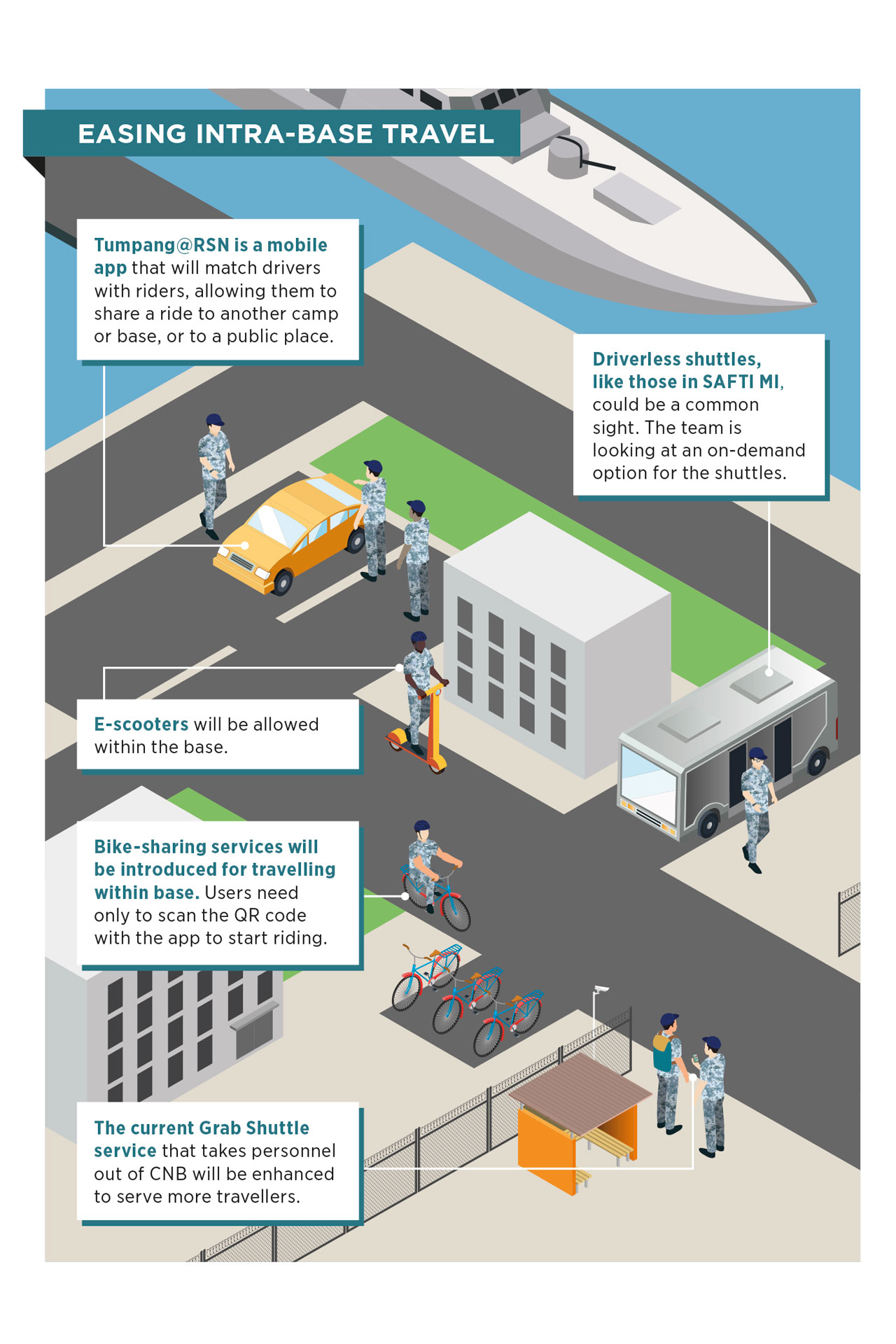
Can tumpang me please?
Move X is going even further with Tumpang@RSN, an app that will allow people to carpool or hitch a ride. And they hope that it will be used by not just RSN personnel, but by the entire civil service.
“It will help lower the carbon footprint — fewer people will buy cars,” said ME5 Jeffrey Tan. The Head of Forward Mission Support Section in FLB added: “There’ll be fewer people requiring public transport, so it will ease the general transportation problems.”
MAJ Chan summed it up: “We are moving towards a car-lite nation after all.”
PITCHFEST 2018
The RSN held its inaugural Pitchfest on 8 Mar. About 500 Navy personnel listened as 15 teams, three from each formation, pitched their ideas to resolve pain points and improve work processes. Using the Inov8 app, the audience were able to vote for the projects they most wanted to see fulfilled. The top three teams received $50,000 each to kick-start their projects while the others received $5,000 each.
“We wanted to catalyse practical innovation,” said ME6 Yau. “If we want to create capacity, we need the formations to take charge and see what are the three big problems they want solved.”
Two of the projects that won the highest number of votes at Pitchfest were the RSN Integrated Transport System and Unmanned Security and Safety Management in Yard.
“The key to innovation is not about the process, the key is making the change on the ground, changing lives and making a difference for everybody,” said Chief of Navy Rear-Admiral Lew Chuen Hong, who presented the seed funds to the teams.
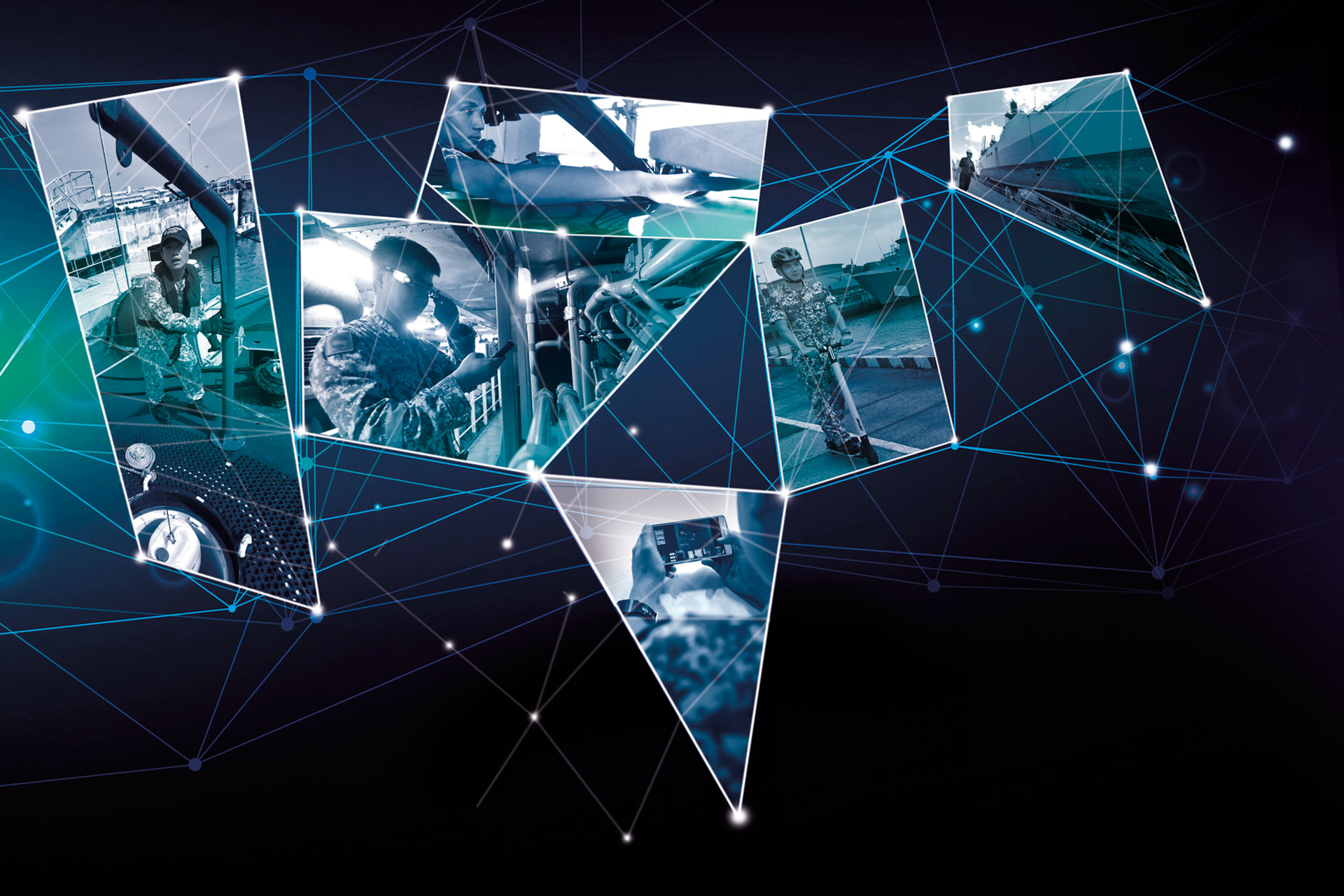
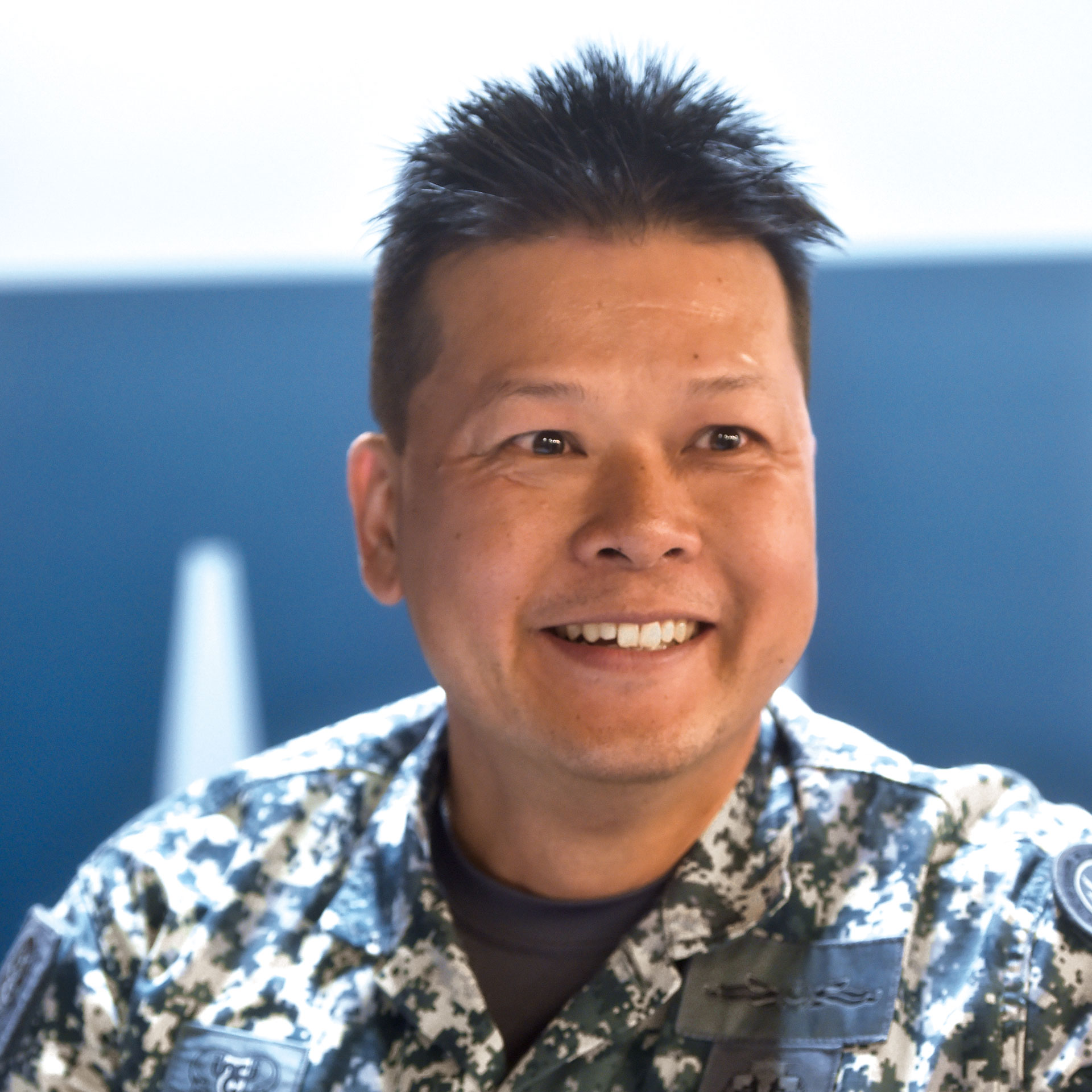
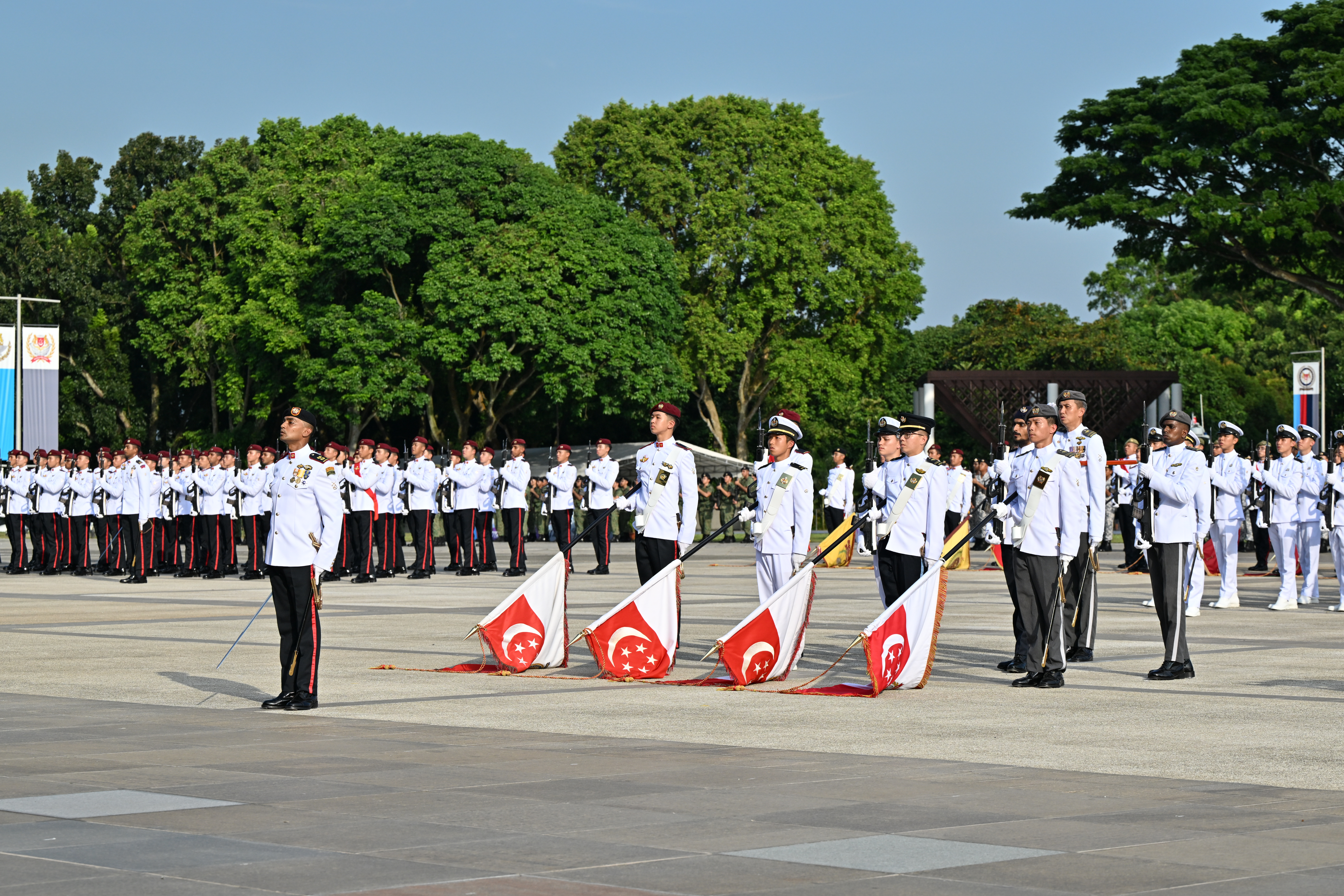
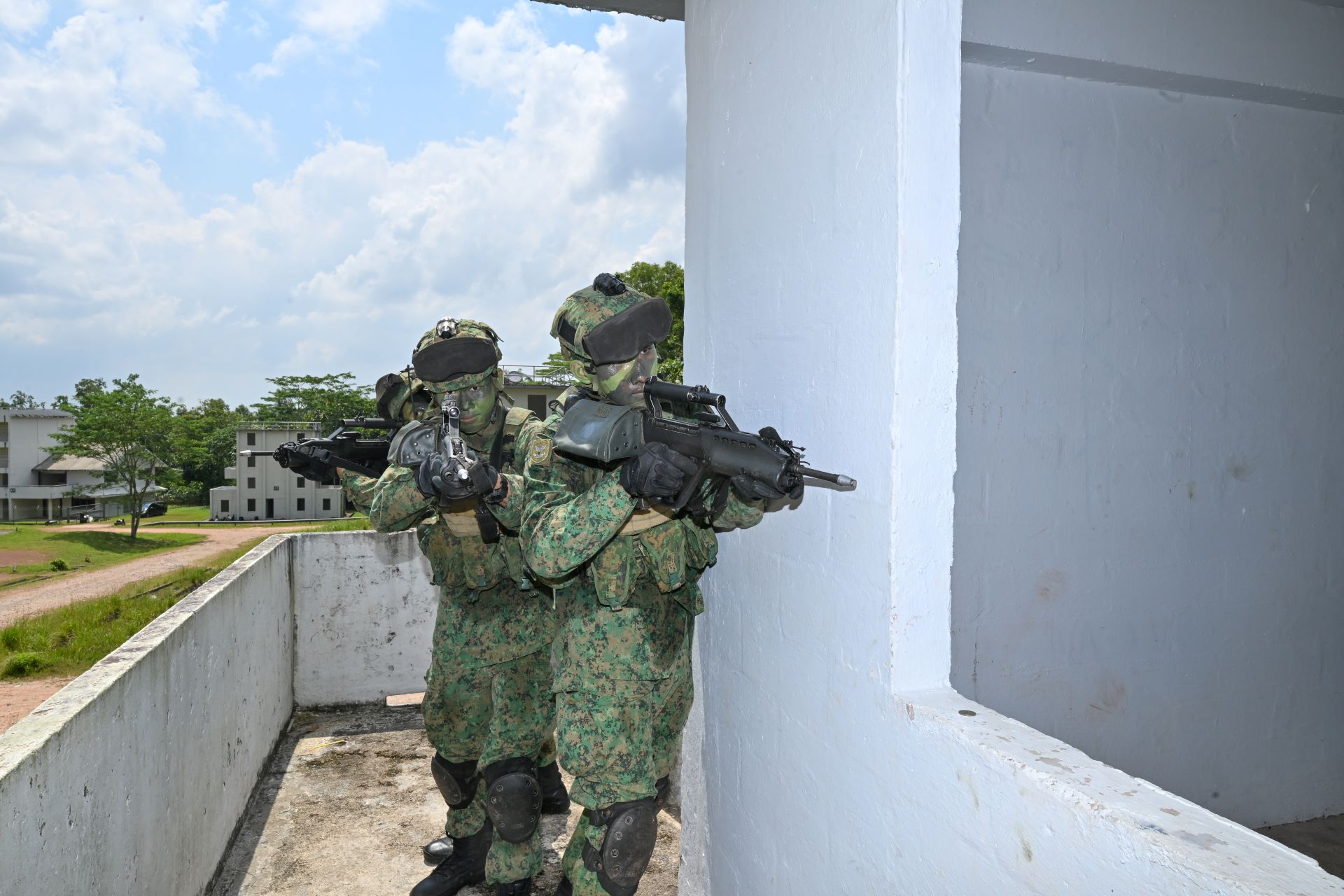
.jpg?sfvrsn=b5383902_1)
.jpg?sfvrsn=4eb1b86e_1)
